In the climate policy world, states and localities are often laboratories of innovation and progress. However, with the devastating impacts of hurricanes, wildfires and heat waves, residents are already experiencing the costly impacts of climate change. To mitigate these costs, EDF supports innovative funding and financing strategies — especially in areas that are most vulnerable to climate impacts. One example of this is EDF’s work on a ballot measure in New York State.
This week, voters passed the historic Clean Water, Clean Air and Green Jobs Environmental Bond Act ballot measure. This comes on the heels of the 10th anniversary of Hurricane Sandy, ushering in a variety of new flood resilience projects aimed at mitigating these risks to communities.














